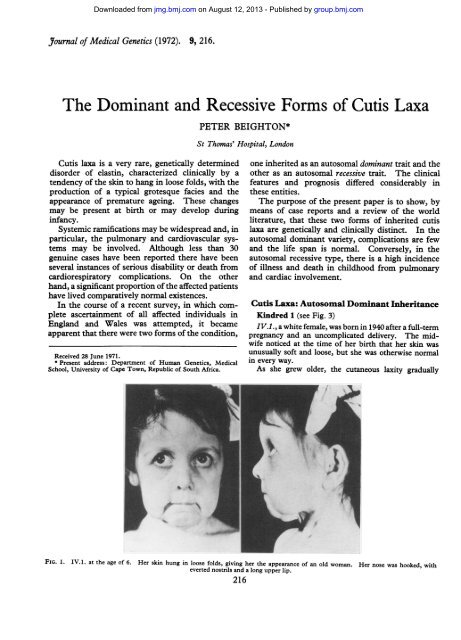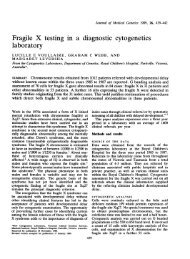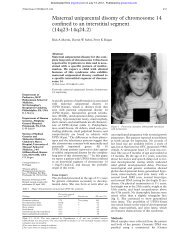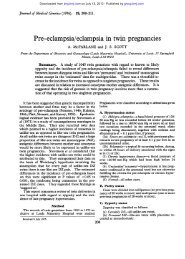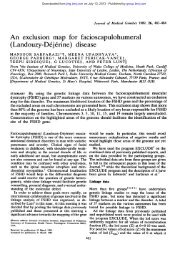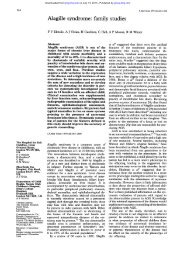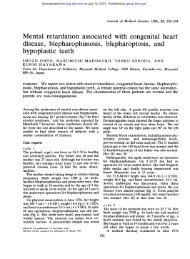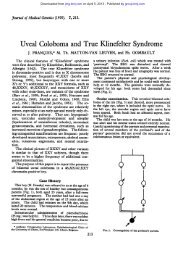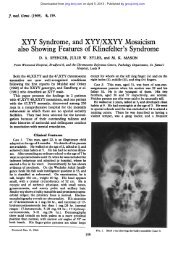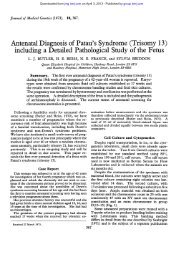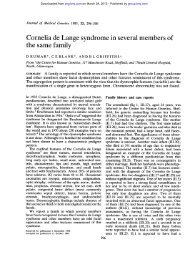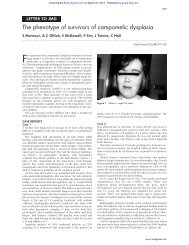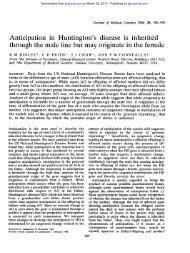The Dominant and Recessive Forms of Cutis Laxa - Journal of ...
The Dominant and Recessive Forms of Cutis Laxa - Journal of ...
The Dominant and Recessive Forms of Cutis Laxa - Journal of ...
Create successful ePaper yourself
Turn your PDF publications into a flip-book with our unique Google optimized e-Paper software.
Downloaded from<br />
jmg.bmj.com on August 12, 2013 - Published by group.bmj.com<br />
<strong>Journal</strong> <strong>of</strong> Medical Genetics (1972). 9, 216.<br />
<strong>The</strong> <strong>Dominant</strong> <strong>and</strong> <strong>Recessive</strong> <strong>Forms</strong> <strong>of</strong> <strong>Cutis</strong> <strong>Laxa</strong><br />
<strong>Cutis</strong> laxa is a very rare, genetically determined<br />
disorder <strong>of</strong> elastin, characterized clinically by a<br />
tendency <strong>of</strong> the skin to hang in loose folds, with the<br />
production <strong>of</strong> a typical grotesque facies <strong>and</strong> the<br />
appearance <strong>of</strong> premature ageing. <strong>The</strong>se changes<br />
may be present at birth or may develop during<br />
infancy.<br />
Systemic ramifications may be widespread <strong>and</strong>, in<br />
particular, the pulmonary <strong>and</strong> cardiovascular systems<br />
may be involved. Although less than 30<br />
genuine cases have been reported there have been<br />
several instances <strong>of</strong> serious disability or death from<br />
cardiorespiratory complications. On the other<br />
h<strong>and</strong>, a significant proportion <strong>of</strong> the affected patients<br />
have lived comparatively normal existences.<br />
In the course <strong>of</strong> a recent survey, in which complete<br />
ascertainment <strong>of</strong> all affected individuals in<br />
Engl<strong>and</strong> <strong>and</strong> Wales was attempted, it became<br />
apparent that there were two forms <strong>of</strong> the condition,<br />
Received 28 June 1971.<br />
* Present address: Department <strong>of</strong> Human Genetics, Medical<br />
School, University <strong>of</strong> Cape Town, Republic <strong>of</strong> South Africa.<br />
PETER BEIGHTON*<br />
St Thomas' Hospital, London<br />
one inherited as an autosomal dominant trait <strong>and</strong> the<br />
other as an autosomal recessive trait. <strong>The</strong> clinical<br />
features <strong>and</strong> prognosis differed considerably in<br />
these entities.<br />
<strong>The</strong> purpose <strong>of</strong> the present paper is to show, by<br />
means <strong>of</strong> case reports <strong>and</strong> a review <strong>of</strong> the world<br />
literature, that these two forms <strong>of</strong> inherited cutis<br />
laxa are genetically <strong>and</strong> clinically distinct. In the<br />
autosomal dominant variety, complications are few<br />
<strong>and</strong> the life span is normal. Conversely, in the<br />
autosomal recessive type, there is a high incidence<br />
<strong>of</strong> illness <strong>and</strong> death in childhood from pulmonary<br />
<strong>and</strong> cardiac involvement.<br />
<strong>Cutis</strong> <strong>Laxa</strong>: Autosomal <strong>Dominant</strong> Inheritance<br />
Kindred 1 (see Fig. 3)<br />
IV.1., a white female, was born in 1940 after a full-term<br />
pregnancy <strong>and</strong> an uncomplicated delivery. <strong>The</strong> midwife<br />
noticed at the time <strong>of</strong> her birth that her skin was<br />
unusually s<strong>of</strong>t <strong>and</strong> loose, but she was otherwise normal<br />
in every way.<br />
As she grew older, the cutaneous laxity gradually<br />
FIG. 1. IV. 1. at the age <strong>of</strong> 6. Her skin hung in loose folds, giving her the appearance <strong>of</strong> an old woman. Her nose was hooked, with<br />
everted nostrils <strong>and</strong> a long upper lip.<br />
216
Downloaded from<br />
jmg.bmj.com on August 12, 2013 - Published by group.bmj.com<br />
worsened. All areas <strong>of</strong> her body were affected, but the<br />
changes were most apparent in her face, where the skin<br />
hung in loose symmetrical folds, giving her the appearance<br />
<strong>of</strong> an old woman (Fig. 1). Indeed, she suffered<br />
greatly from teasing <strong>of</strong> her school fellows, who called her<br />
'funny-face' or 'granny'.<br />
Apart from pneumonia in early childhood, her general<br />
health remained good, <strong>and</strong> at the age <strong>of</strong> 6, she had extensive<br />
plastic surgery to her face. <strong>The</strong>re were no<br />
problems at operation, healing was rapid, <strong>and</strong> the end<br />
result was satisfactory. At this time, her case history<br />
was presented before the Royal Society <strong>of</strong> Medicine<br />
(Lewis, 1948).<br />
Her later childhood was uneventful, <strong>and</strong> she did not<br />
have dyspnoea when she played games at school. In the<br />
second decade <strong>of</strong> her life, she had three more bouts <strong>of</strong><br />
pneumonia, <strong>and</strong> at the age <strong>of</strong> 21, bronchiectasis was<br />
diagnosed. Since that time, her pulmonary condition<br />
has only been a minor nuisance, causing slight dyspnoea<br />
on severe exertion <strong>and</strong> an intermittent productive cough.<br />
She married <strong>and</strong> gave birth to a normal daughter.<br />
Later, 2 miscarriages occurred, each at 8 weeks, <strong>and</strong><br />
subsequently, an affected daughter (V.4) was born.<br />
<strong>The</strong> patient was Rhesus negative, <strong>and</strong> antibodies developed<br />
during her last pregnancy. No complication<br />
occurred at her deliveries.<br />
Examination in December 1969 revealed a cheerful,<br />
lively young woman, with a deep voice. Her nose was<br />
hooked, with everted nostrils, <strong>and</strong> her upper lip was<br />
long. Her facial skin was pendulous, her ears sagged,<br />
<strong>and</strong> her cheeks hung in smooth folds. She looked older<br />
than her years, but was by no means ugly or deformed.<br />
<strong>The</strong> skin <strong>of</strong> her body was s<strong>of</strong>t <strong>and</strong> somewhat loose, <strong>and</strong> it<br />
tended to hang, particularly on her knees <strong>and</strong> elbows.<br />
Her height was 167 cm, her weight was 50-8 kg, <strong>and</strong><br />
she was normally proportioned. Her hair <strong>and</strong> teeth<br />
were normal. <strong>The</strong>re was no skeletal deformity, <strong>and</strong> the<br />
joints were not hypermobile. Crepitations were audible<br />
at the base <strong>of</strong> her left lung, but her cardiovascular system<br />
was normal. A right inguinal hernia was the only<br />
abdominal abnormality, <strong>and</strong> there were no abnormal<br />
signs in her central nervous system.<br />
V.4, the second daughter <strong>of</strong> IV.1., was born in<br />
1968. She weighed 2835 g <strong>and</strong> at birth her mother was<br />
able to make an immediate diagnosis <strong>of</strong> cutis laxa. <strong>The</strong><br />
child's cutaneous features were very similar to those <strong>of</strong><br />
her mother, but she was otherwise quite well.<br />
When she was 6 months old, a systolic murmur was<br />
heard, <strong>and</strong> a tentative diagnosis <strong>of</strong> a small ventricular<br />
septal defect was made. However, she has remained a<br />
vigorous, happy child without any symptoms which<br />
might be referable to the heart or lungs.<br />
On examination at the age <strong>of</strong> 18 months, she was a<br />
plump, intelligent infant, with lax skin on the upper<br />
eyelids, cheeks, neck, <strong>and</strong> trunk. <strong>The</strong>se changes were<br />
<strong>of</strong> moderate degree, but she was affected more severely<br />
than her mother (Fig. 2). <strong>The</strong> hair, teeth, skeleton, <strong>and</strong><br />
joints were normal, her voice was deep, <strong>and</strong> her nose <strong>and</strong><br />
upper lip resembled those <strong>of</strong> the mother. <strong>The</strong> lungs<br />
<strong>The</strong> <strong>Dominant</strong> <strong>and</strong> <strong>Recessive</strong> <strong>Forms</strong> <strong>of</strong> <strong>Cutis</strong> <strong>Laxa</strong><br />
217<br />
FIG. 2. <strong>Dominant</strong> cutis laxa. IV.1 <strong>and</strong> her daughter V.4. At<br />
the time that this picture was taken, IV. 1 was 28 years <strong>of</strong> age, while<br />
V.4 was in early infancy. Due to the laxity <strong>of</strong> their facial skin,<br />
they both appeared to be much older.<br />
<strong>and</strong> central nervous system were normal, but a systolic<br />
murmur was audible over the 3rd <strong>and</strong> 4th intercostal<br />
spaces, at the left sternal edge.<br />
III.2., the mother <strong>of</strong> IV.1., was noticed to have lax<br />
skin at her birth in 1920. Although she always looked<br />
much older than her true age, her condition had caused<br />
no great disability, <strong>and</strong> cosmetic surgery was never<br />
undertaken. <strong>The</strong> skin <strong>of</strong> all areas was affected, but the<br />
changes were maximal on her cheeks <strong>and</strong> neck.<br />
Her general health was good, <strong>and</strong> operations for<br />
appendicitis, a left inguinal hernia, <strong>and</strong> a uterine prolapse<br />
were uneventful. She developed dyspnoea <strong>and</strong> a<br />
persistent cough in her late thirties, <strong>and</strong> bronchiectasis<br />
was diagnosed when she was 45 years <strong>of</strong> age.<br />
<strong>The</strong> patient declined examination, but reports from<br />
her daughter's general practitioner, plastic surgeon, <strong>and</strong><br />
paediatrician, together with a perusal <strong>of</strong> family photographs,<br />
established the diagnosis beyond any doubt.<br />
I
218<br />
T<br />
II<br />
III<br />
Iv<br />
IV<br />
II<br />
III<br />
Downloaded from<br />
jmg.bmj.com on August 12, 2013 - Published by group.bmj.com<br />
3<br />
Peter Beighton<br />
DOMINANT INHERITANCE<br />
RECESSIVE INHERITANCE<br />
Normal male<br />
Normal female<br />
Affected male<br />
Affected female<br />
2<br />
1 Male, probably affected<br />
Mscarriage<br />
Mole, deceased<br />
a Female, deceased<br />
\ Probcnd<br />
FIG. 3. Pedigrees. <strong>The</strong> pedigrees <strong>of</strong> kindreds 1 <strong>and</strong> 2 indicate autosomal dominant transmission <strong>of</strong> the trait.<br />
<strong>The</strong> presence <strong>of</strong> consanguinity in the other two pedigrees is suggestive <strong>of</strong> autosomal recessive inheritance.<br />
Other members <strong>of</strong> kindred 1. <strong>The</strong> mother 111.2 <strong>and</strong><br />
one <strong>of</strong> her brothers <strong>and</strong> his son, were also thought by<br />
the family to be affected, but these individuals could not<br />
be contacted (pedigree 1, Fig. 3).<br />
Kindred 2<br />
III.1., a white male, was born in 1962 after an uneventful<br />
pregnancy <strong>and</strong> a normal delivery. He weighed<br />
2210 g at birth, <strong>and</strong> was apparently quite well.<br />
He remained in good health during infancy but when<br />
he was one year old, a systolic murmur was heard, <strong>and</strong> it<br />
was suggested that he might have a small ventricular<br />
septal defect. <strong>The</strong> physician making this examination<br />
noted that he was <strong>of</strong> normal intelligence, plump, <strong>and</strong><br />
'looking older than his age'. By the age <strong>of</strong> 4 it was apparent<br />
that his skinfolds had become excessive, particularly<br />
on the cheeks <strong>and</strong> neck.<br />
One year later the skin <strong>of</strong> his face, trunk, <strong>and</strong> limbs had<br />
become strikingly loose, <strong>and</strong> he had been teased at<br />
school because <strong>of</strong> his 'old man' appearance. His murmur<br />
was unchanged, <strong>and</strong> he had no symptoms <strong>of</strong> cardiac<br />
or pulmonary involvement. At this time his mother,<br />
who was then 29 years <strong>of</strong> age, was said to resemble a<br />
woman <strong>of</strong> 50.<br />
<strong>The</strong> diagnosis <strong>of</strong> cutis laxa was now made, <strong>and</strong> in<br />
addition to the mother, a study <strong>of</strong> the family indicated<br />
that an uncle <strong>and</strong> the maternal gr<strong>and</strong>father were also<br />
probably affected (pedigree 2, Fig. 3).<br />
D<br />
0<br />
0<br />
<strong>Cutis</strong> <strong>Laxa</strong>: Autosomal <strong>Recessive</strong> Inheritance<br />
Kindred 3<br />
II.6., a white male, weighed 3742 g at his birth in<br />
1965, after a full-term pregnancy <strong>and</strong> normal delivery.<br />
Pronounced dermal changes were apparent at this<br />
time; his skin hung in loose folds in all areas <strong>of</strong> his face,<br />
trunk, <strong>and</strong> limbs in such a way that it appeared to be<br />
'too big for him'. In addition to his lugubrious facies<br />
<strong>and</strong> everted lower eyelids, he had the characteristic<br />
hooked nose, short columella, <strong>and</strong> long upper lip. His<br />
cry was hoarse <strong>and</strong> a huge obturator hernia was present.<br />
Persistent vomiting during the first week <strong>of</strong> life led to a<br />
diagnosis <strong>of</strong> pyloric stenosis. This abnormality was subsequently<br />
corrected at an uneventful operation.<br />
When he was 3 weeks old radiography <strong>of</strong> the chest revealed<br />
gross emphysema, <strong>and</strong> an electrocardiogram<br />
showed evidence <strong>of</strong> considerable right ventricular<br />
hypertrophy.<br />
By the end <strong>of</strong> his first year, he had had several episodes<br />
<strong>of</strong> pneumonia, <strong>and</strong> at this time there was radiographic<br />
evidence <strong>of</strong> considerable worsening <strong>of</strong> the<br />
emphysema. <strong>The</strong> electrocardiogram now indicated increased<br />
right ventricular hypertrophy <strong>and</strong> strain. <strong>The</strong><br />
skin abnormalities were unchanged <strong>and</strong> his general<br />
health was very poor. His condition continued to<br />
deteriorate <strong>and</strong> he died in his second year, from cardiorespiratory<br />
complications.<br />
His parents, who were first cousins, were clinically
Downloaded from<br />
jmg.bmj.com on August 12, 2013 - Published by group.bmj.com<br />
normal. Five elder brothers were also normal <strong>and</strong> no<br />
other members <strong>of</strong> the kindred were known to have cutaneous<br />
laxity (pedigree 3, Fig. 3).<br />
Kindred 4<br />
III.1., a white female, weighed 3288 g at her birth in<br />
1965, which had followed a normal pregnancy <strong>and</strong> delivery.<br />
At this time it was noted that she had lax skin in all<br />
regions <strong>of</strong> the body <strong>and</strong> limbs. She had a deep husky<br />
cry <strong>and</strong> the characteristic mournful facies. A loud systolic<br />
murmur was present over the praecordium <strong>and</strong> the<br />
thorax was hyper-resonant to percussion. <strong>The</strong>re was no<br />
articular hypermobility, <strong>and</strong> the skin was neither fragile<br />
nor hyperelastic.<br />
Her general health was poor during infancy <strong>and</strong> the<br />
early months <strong>of</strong> her life were punctuated by repeated<br />
chest infections. Her cutaneous condition gradually<br />
increased in severity. When she was 2 years <strong>of</strong> age, the<br />
family moved to another part <strong>of</strong> the country. Nothing<br />
is known <strong>of</strong> her subsequent progress.<br />
<strong>The</strong> patient was the product <strong>of</strong> an incestuous union<br />
between her father <strong>and</strong> his own 15-year-old daughter.<br />
This daughter later married a young man <strong>and</strong> had a<br />
normal child. <strong>The</strong>se individuals had no dermal abnormalities<br />
<strong>and</strong> there was no history <strong>of</strong> cutaneous laxity in<br />
any other members <strong>of</strong> the kindreds (pedigree 4, Fig. 3).<br />
Discussion<br />
<strong>The</strong> nosology <strong>of</strong> cutis laxa is complex, <strong>and</strong> among<br />
the many designations which have been employed<br />
are elastolysis, chalazoderma, <strong>and</strong> cutis pendula.<br />
<strong>Cutis</strong> laxa has <strong>of</strong>ten been confused with the Ehlers-<br />
Danlos syndrome, but this latter entity is readily<br />
differentiated by the presence <strong>of</strong> joint hypermobility,<br />
together with fragility <strong>and</strong> hyperextensibility <strong>of</strong> the<br />
skin (Beighton, 1970).<br />
<strong>The</strong> <strong>Dominant</strong> <strong>and</strong> <strong>Recessive</strong> <strong>Forms</strong> <strong>of</strong> <strong>Cutis</strong> <strong>Laxa</strong><br />
TABLE I<br />
DOMINANT INHERITANCE OF CUTIS LAXA<br />
Inherited cutis laxa is also quite distinct from an<br />
acquired form <strong>of</strong> cutis laxa which develops later in<br />
life, sometimes after an ill-defined febrile illness.<br />
Patients affected by genetically determined cutis<br />
laxa have a hooked nose, with a long columella <strong>and</strong><br />
everted nostrils, while in the other varieties <strong>of</strong> cutis<br />
laxa, the nose is normal in configuration (Beighton,<br />
Bull, <strong>and</strong> Edgerton, 1970).<br />
Localized areas <strong>of</strong> loose skin may develop in<br />
neur<strong>of</strong>ibromatosis <strong>and</strong> in atrophic scars which<br />
follow dermal lesions <strong>of</strong> granulomatous conditions<br />
such as syphilis <strong>and</strong> sarcoidosis. Circumscribed<br />
cutaneous laxity may also develop in affected<br />
regions in the late stages <strong>of</strong> pseudoxanthoma elasticum.<br />
On clinical examination, it is usually obvious<br />
that cutis laxa is a secondary manifestation in these<br />
disorders. This complex situation was clarified by<br />
Marshall, Vogelpoel, <strong>and</strong> Weber (1960), who proposed<br />
an excellent classification <strong>of</strong> the various forms<br />
<strong>of</strong> cutis laxa.<br />
In many <strong>of</strong> the cases which have been reported in<br />
the world literature, there has been nothing to<br />
indicate a particular mode <strong>of</strong> inheritance <strong>of</strong> the<br />
disorder. However, in a proportion <strong>of</strong> these<br />
descriptions, there is evidence <strong>of</strong> either dominant or<br />
recessive transmission <strong>of</strong> the trait (Tables I <strong>and</strong> II).<br />
<strong>The</strong> pedigrees <strong>of</strong> kindreds 1 <strong>and</strong> 2 (see Fig. 3)<br />
are consistent with autosomal dominant inheritance<br />
<strong>of</strong> cutaneous laxity. Equally, the family histories<br />
<strong>of</strong> the patients listed in Table I indicate dominant<br />
inheritance. It is noteworthy that the majority <strong>of</strong><br />
these individuals enjoyed good health, apart from<br />
their dermal changes. Although some <strong>of</strong> them had<br />
pulmonary or cardiovascular manifestations, these<br />
were <strong>of</strong> mild degree, <strong>and</strong> caused little inconvenience.<br />
Author Clinical Features Family History<br />
Graf (1836) d Cutaneous laxity; no systemic ramifications; Gr<strong>and</strong>father, uncle, <strong>and</strong> aunt similarly affected<br />
onset in middle age<br />
Rossbach (1884) d Cutaneous laxity; onset at 18 Affected son (Kopp's patient)<br />
Kopp (1888) d Cutaneous laxity present at birth Affected father (Rossbach's patient)<br />
Talbot (1923) 9 Cutaneous laxity apparent in infancy; otherwise Mother affected<br />
healthy<br />
Lewis (1948) V Loose skin since infancy; bilateral face lift Mother affected (see pedigree 1, Fig. 3)<br />
performed at the age <strong>of</strong> 7<br />
Sestak (1962) Loose skin since birth; general health good Affected father<br />
(patients depicted by Reidy<br />
(1963])<br />
Balboni (1963) d Cutaneous laxity apparent in infancy; health Father <strong>and</strong> uncle affected; father had radiological<br />
good but angiography demonstrated evidence <strong>of</strong> similar vascular abnormalities<br />
abnormalities <strong>of</strong> the aorta <strong>and</strong> great vessels<br />
Hayden, Talner, <strong>and</strong> Klaus d Loose skin; pulmonary artery stenosis found in Father, patemal aunt, gr<strong>and</strong>mother, <strong>and</strong> great<br />
(1968) early childhood I gr<strong>and</strong>mother affected<br />
219
220<br />
Downloaded from<br />
jmg.bmj.com on August 12, 2013 - Published by group.bmj.com<br />
Peter Beighton<br />
TABLE II<br />
RECESSIVE INHERITANCE OF CUTIS LAXA<br />
Author Clinical Features Family History<br />
Siegmund (1938) Infant with loose skin <strong>and</strong> pulmonary emphysema Affected sib<br />
Fittke (1942) (patient restudied Three affected sisters with loose skin <strong>and</strong> skeletal Parents consanguineous; affected cousin<br />
by <strong>The</strong>opold <strong>and</strong> Wildhack abnormalities<br />
[1951])<br />
Cashman (1957) (kindred studied Severely affected girl, with pulmonary emphysema <strong>and</strong> Parents consanguineous<br />
by Sestak [1962]) recurrent chest infection<br />
Goltz et al (1965) Two brothers with loose skin, emphysema <strong>and</strong> cor Parents <strong>and</strong> sister normal<br />
pulmonale; younger brother died at 15 months from<br />
cardiorespiratory complications<br />
K. Aterman (personal Three affected brothers each with gross cutaneous Parents <strong>and</strong> one brother normal<br />
communication) laxity <strong>and</strong> massive aneurysm <strong>of</strong> the ascending aorta;<br />
all died in infancy<br />
It is also <strong>of</strong> interest that although the skin laxity Wildhack (1951) have frequently been quoted as<br />
was usually noted in infancy, in some instances the examples <strong>of</strong> recessively inherited cutis laxa, but in<br />
changes were delayed until adult life (Graf, 1836; view <strong>of</strong> their concomittant skeletal abnormalities it is<br />
Rossbach, 1884). This late onset had also been more likely that they had the rare disorder which<br />
observed in other affected individuals (Bettman, was described Debre, Marie, <strong>and</strong> Seringe (1937).<br />
1955; Reed, Horowitz, <strong>and</strong> Beighton, 1971), <strong>and</strong> it Although the total number <strong>of</strong> cases are few, the<br />
is possible that they have a distinct variety <strong>of</strong> the available evidence points strongly to the existence<br />
disorder. On the other h<strong>and</strong>, variable penetrance <strong>of</strong> dominant <strong>and</strong> recessive forms <strong>of</strong> cutis laxa as<br />
<strong>of</strong> the gene could account for this variability in separate <strong>and</strong> distinct entities. In the kindreds<br />
clinical manifestations. described in this paper, <strong>and</strong> those culled from the<br />
Schreiber <strong>and</strong> Tilley (1961) published an ex- literature, the dominant form <strong>of</strong> cutis laxa has always<br />
tensive pedigree <strong>of</strong> an affected kindred, in which been benign, with little in the way <strong>of</strong> systemic<br />
there was clear evidence <strong>of</strong> dominant inheritance. ramifications. On the other h<strong>and</strong>, the dermal <strong>and</strong><br />
However, from their case descriptions, it seems that systemic manifestations have been consistently<br />
these patients had the acromegaloid-cutis verticis severe in the recessive variety.<br />
gyrata-corneal leukoma syndrome <strong>of</strong> Rosenthal <strong>and</strong> In recent years, many uncommon disorders have<br />
Kloepfer (1962), rather than true cutis laxa. been shown to be heterogeneous. <strong>The</strong> dominant<br />
Similarly, the family described by Wiener (1925) forms are usually relatively harmless while the realmost<br />
certainly had the Ehlers-Danlos syndrome. cessive types tend to have serious consequences<br />
Notwithst<strong>and</strong>ing these latter kindreds, there is still (McKusick, 1966). <strong>The</strong> nature <strong>of</strong> the dominant<br />
substantial evidence to indicate the existence <strong>of</strong> a <strong>and</strong> recessive forms <strong>of</strong> cutis laxa is in accordance<br />
benign form <strong>of</strong> cutis laxa, which is inherited as an with this principal.<br />
autosomal dominant trait. r <strong>The</strong> elegant histological <strong>and</strong> electron micro-<br />
<strong>The</strong> presence <strong>of</strong> major degrees <strong>of</strong> parental con- ) scopical studies <strong>of</strong> Goltz et al (1965) have indicated<br />
sanguinity in kindreds 3 <strong>and</strong> 4 (see Fig. 3) is strongly f that the elastin is abnormal in cutis laxa. Investigasuggestive<br />
<strong>of</strong> an autosomal recessive mode <strong>of</strong> in- tion <strong>of</strong> the physical properties <strong>of</strong> the skin <strong>of</strong> affected<br />
heritance <strong>of</strong> the trait. This viewpoint is supported individuals have supported this viewpoint (Grahame<br />
by the absence <strong>of</strong> the disorder in the parents or <strong>and</strong> Beighton, 1971). As in other inherited connecother<br />
members <strong>of</strong> the kindreds. tive tissue disorders, it is possible that there is an<br />
Previously reported cases in which there is evi- abnormality or substitution <strong>of</strong> an amino acid in the<br />
dence <strong>of</strong> autosomal recessive inheritance are shown polypeptide chain <strong>of</strong> the elastin molecule in the<br />
in Table II. In the majority <strong>of</strong> these individuals, dominant variety. In the recessive form, an enthe<br />
dermal changes were severe <strong>and</strong> cardiac or zyme defect may be present. As yet, however, the<br />
pulmonary involvement was frequent. Many <strong>of</strong> nature <strong>of</strong> the primary defect is unknown.<br />
them died during childhood from cardiorespiratory <strong>The</strong> delineation <strong>of</strong> the dominant <strong>and</strong> recessive<br />
complications. forms <strong>of</strong> cutis laxa is <strong>of</strong> importance in genetic<br />
<strong>The</strong> affected sisters who were reported by Fittke counselling <strong>and</strong> clinical prognostication. Eventu-<br />
(1942) <strong>and</strong> later restudied by <strong>The</strong>opold <strong>and</strong> ally, when suitable techniques become available,
it may serve as a basis for the recognition <strong>of</strong> an<br />
affected fetus in utero in the dominant variety <strong>of</strong> the<br />
condition, <strong>and</strong> <strong>of</strong> the heterozygous carrier <strong>of</strong> the<br />
abnormal gene in the recessive form <strong>of</strong> cutis laxa.<br />
Summary<br />
<strong>The</strong> hypothesis that there are separate autosomal<br />
dominant <strong>and</strong> autosomal recessive varieties <strong>of</strong> genetically<br />
determined cutis laxa is supported by case<br />
reports <strong>and</strong> a review <strong>of</strong> the world literature.<br />
In the dominant form, the changes are mild <strong>and</strong><br />
largely confined to the dermis. Conversely, in the<br />
recessive type <strong>of</strong> cutis laxa, the skin lesions are<br />
severe <strong>and</strong> pulmonary <strong>and</strong> cardiovascular involvement<br />
is common. In this type <strong>of</strong> the condition,<br />
these complications <strong>of</strong>ten lead to death during<br />
childhood.<br />
My thanks are due to Dr Florence Char <strong>of</strong> Little<br />
Rock, Dr R. Prosser <strong>of</strong> the Royal Gwent Hospital,<br />
Newport, <strong>and</strong> Dr N. Hay <strong>of</strong> Liverpool for their kind<br />
permission to publish the details <strong>of</strong> patients in their<br />
care.<br />
Miss G. Winch HV, SRN (now Mrs G. Beighton)<br />
played an important part in the preliminary investigation<br />
<strong>and</strong> later typed the manuscript with enthusiasm <strong>and</strong><br />
efficiency.<br />
<strong>The</strong> author was supported by a grant from the St<br />
Thomas' Hospital Endowment Fund.<br />
REERENCES<br />
Balboni, F. A. (1963). <strong>Cutis</strong> laxa <strong>and</strong> multiple vascular anomalies.<br />
Bulletin <strong>of</strong> the St Francis Hospital, 19, 26-34.<br />
Beighton, P. H. (1970). <strong>The</strong> Ehlers-Danlos Syndrome, 1st ed.,<br />
p. 1200. Heinemann, London.<br />
Beighton, P. H., Bull, J. S., <strong>and</strong> Edgerton, M. (1970). Plastic<br />
surgery in cutis laxa. British J7ournal <strong>of</strong> Plastic Surgery, 23, 285-<br />
290.<br />
Downloaded from<br />
jmg.bmj.com on August 12, 2013 - Published by group.bmj.com<br />
<strong>The</strong> <strong>Dominant</strong> <strong>and</strong> <strong>Recessive</strong> <strong>Forms</strong> <strong>of</strong> <strong>Cutis</strong> <strong>Laxa</strong><br />
221<br />
Bettman, A. G. (1955). Excessively relaxed skin <strong>and</strong> the pituitary<br />
gl<strong>and</strong>. Plastic <strong>and</strong> Reconstructive Surgery, 15, 489-501.<br />
Cashman, M. E. (1957). <strong>Cutis</strong> laxa-case demonstration. Proceedings<br />
<strong>of</strong> the Royal Society <strong>of</strong> Medicine, 50, 719-720.<br />
Debre, R., Marie, J., <strong>and</strong> Seringe, P. (1937). '<strong>Cutis</strong> <strong>Laxa</strong>' avec<br />
dystrophies osseuses. Bulletin et Memoires de la Sociltd de<br />
Mddecine de Paris, 53, 1038-1039.<br />
Fittke, H. (1942). OYber eine ungewohnliche Form 'Multipler<br />
Erbabartung' (Chalodermie <strong>and</strong> Dysosteose). Zeitschrift fur<br />
Kinderheilkunde, 63, 510-523.<br />
Goltz, R. W., Hult, A. M., Goldfarb, M., <strong>and</strong> Gorlin, R. J. (1965).<br />
<strong>Cutis</strong> laxa-a manifestation <strong>of</strong> generalised elastolysis. Archives <strong>of</strong><br />
Dermatology, 92, 373-387.<br />
Graf (1836). Ortliche erbliche Erschliffung der Hawr. Wochenschrift<br />
fur die gesammte Heilkunde (Berlin), 15, 225-230.<br />
Grahame, R. <strong>and</strong> Beighton, P. (1971). <strong>The</strong> physical properties <strong>of</strong><br />
skin in cutis laxa. British <strong>Journal</strong> <strong>of</strong> Dermatology, 84, 326-329.<br />
Hayden, J. G., Talner, N. S., <strong>and</strong> Klaus, S. N. (1968). <strong>Cutis</strong> laxa<br />
associated with pulmonary artery stenosis. <strong>Journal</strong> <strong>of</strong> Pediatrics,<br />
72, 506-509.<br />
Kopp, W. (1888). Demonstration zweier Falle von <strong>Cutis</strong> <strong>Laxa</strong><br />
(Vater und Sohn). Munchener medizinische IX ochenschrift, 35,<br />
259-260.<br />
Lewis, E. (1948). <strong>Cutis</strong> laxa. Proceedings <strong>of</strong> the Royal Society <strong>of</strong><br />
Medicine, 41, 864-865.<br />
Marshall, J., Vogelpoel, L., <strong>and</strong> Weber, H. W. (1960). Primary<br />
elastolysis. South African Medical<strong>Journal</strong>, 34, 721-727.<br />
McKusick, V. A. (1966). Heritable Disorders <strong>of</strong> Connective Tissue,<br />
3rd ed, p. 5. Mosby, St Louis <strong>and</strong> London.<br />
Reed, W. B., Horowitz, R. A., <strong>and</strong> Beighton, P. H. (1971). Acquired<br />
cutis laxa. Archives <strong>of</strong> Dermatology, 103, 661-669.<br />
Reidy, J. P. (1963). <strong>Cutis</strong> hyperelastica (Ehlers-Danlos) <strong>and</strong> cutis<br />
laxa. British <strong>Journal</strong> <strong>of</strong> Plastic Surgery, 16, 84-94.<br />
Rosenthal, J. W. <strong>and</strong> Kloepfer, H. W. (1962). An acromegaloid,<br />
cutis verticis gyrata, corneal leukoma syndrome, a new medical<br />
entity. Archives <strong>of</strong> Ophthalmology, 68, 722-726.<br />
Rossbach, M. J. (1884). Ein merkwurdiger Fall von greisenhafter<br />
Ver<strong>and</strong>erung der allgemeinen Korperdicke bei einem achtzehnjahrigen<br />
Jungling. Deutsches Archiv fur Klinische Medizin, 36,<br />
197-202.<br />
Schreiber, M. M. <strong>and</strong> Tilley, J. C. (1961). <strong>Cutis</strong> laxa. Archives <strong>of</strong><br />
Dermatology, 84, 266-272.<br />
Sestak, Z. (1962). Ehlers-Danlos syndrome <strong>and</strong> cutis laxa: an<br />
account <strong>of</strong> families in the Oxford area. Annals <strong>of</strong> Human Genetics,<br />
25, 313-321.<br />
Siegmund, H. (1938). tber das sog. Oedema lymphangiectaticum.<br />
Zentralblatt fur allgemeine Pathologie und pathologische Anatomic,<br />
70,243-247.<br />
Talbot, F. B. (1923). Metabolism study <strong>of</strong> a case simulating premature<br />
senility. Monatsschrift fur Kinderheilkunde, 25, 643-646.<br />
<strong>The</strong>opold, W. <strong>and</strong> Wildhack, R. (1951). Dermatochalasis in<br />
Rahmen multipler Abartungen. Monatsschrift fur Kinderheilkunde,<br />
99, 213-218.<br />
Wiener, K. (1925). Gummihaut (cutis laxa) mit dominanter<br />
Vererbung. Archiv fir Dermatologie und Syphilis, 148, 599-601.
Downloaded from<br />
jmg.bmj.com on August 12, 2013 - Published by group.bmj.com<br />
References<br />
Email alerting<br />
service<br />
Notes<br />
<strong>The</strong> dominant <strong>and</strong> recessive<br />
forms <strong>of</strong> cutis laxa.<br />
P Beighton<br />
J Med Genet 1972 9: 216-221<br />
doi: 10.1136/jmg.9.2.216<br />
Updated information <strong>and</strong> services can be found<br />
at:<br />
http://jmg.bmj.com/content/9/2/216.citation<br />
<strong>The</strong>se include:<br />
To request permissions go to:<br />
http://group.bmj.com/group/rights-licensing/permissions<br />
To order reprints go to:<br />
http://journals.bmj.com/cgi/reprintform<br />
To subscribe to BMJ go to:<br />
http://group.bmj.com/subscribe/<br />
Article cited in:<br />
http://jmg.bmj.com/content/9/2/216.citation#related-urls<br />
Receive free email alerts when new articles cite<br />
this article. Sign up in the box at the top right<br />
corner <strong>of</strong> the online article.


